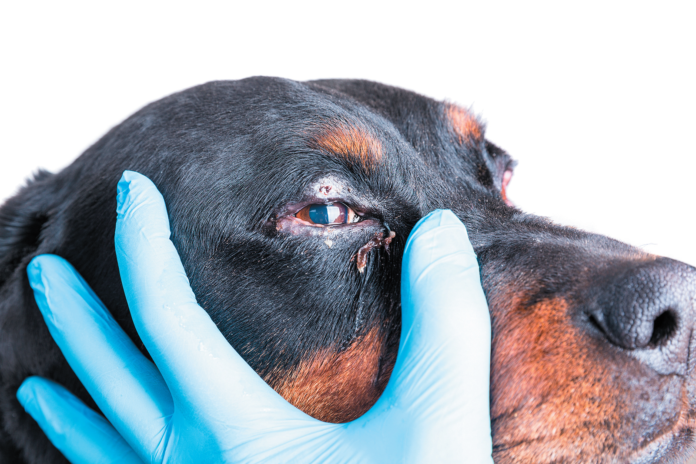The color of discharge coming out of your dog’s eye can tell you a lot about whether something is wrong or if the “gook” is normal. The color key below will help you determine whether a vet visit is in order.
White. White discharge that’s not excessive, especially if it’s in the inner corner of an eye, is perfectly healthy and nothing to be concerned about. You can use some warm water and a cotton ball to get rid of it. Don’t rub the eye and get cotton in it. Just go along the lower lid. Usually the discharge will be thick and tenacious and just stick to the cotton ball. It will then pull right out.
Clear. Clear discharge, like white, is a non-issue. The only time clear or white discharge should raise concern is if it’s excessive and starts accumulating again within minutes of removing it. In that case, it should be checked out by a doctor.
Green to greenish-yellow. Green or yellow pus-like gook often means there’s inflammation in the eye. Consider that an inflamed eye will produce discharge. And since there are always bacteria around the eye, they will make their way into the discharge and change it from a clear-to-white mucus to a deeper color.
Why would a dog’s eye become inflamed? One of the major causes is dry eye, known medically as keratoconjunctivitis sicca. If the eye is not getting enough tears, the glands that produce mucus and oils start to over-produce in an effort to compensate, and bacteria migrate to the viscous material.
Some other causes of green to yellowish pus include foreign bodies in the cornea or other parts of the eye, a corneal ulcer, and extra lashes curling into rather than away from the eye. They all require veterinary care. For instance, lashes going in the wrong direction need to be removed permanently by a veterinarian rather than plucked.
A change in the color of the eye itself
Sometimes a color change right on the eye is a sign of a medical issue.
Red. If a dog gets red eye but it dissipates on its own within 24 hours, it probably just means there was a minor irritant. Otherwise, red eye is a red flag. The problem can be anything from damage to the cornea (the transparent, protective covering over the eye) to tick-borne disease. Especially if the red eye comes on out of nowhere, get your dog to the vet.
If the entire eye turns red — not just the white of the eye but also the pupil and the brown or blue iris — it means there has been bleeding inside the eye, possibly with inflammation of the conjunctival tissue that covers the white part of the eye.
From Black to White. If the pupil goes from black to white, it generally means a cataract is forming.
From Black to Bluish-Grey. If the pupil goes from black to bluish-grey, it’s probably lenticular sclerosis, a condition of aging that makes the eye look cloudy but does not result in significant vision loss.
Note: Even with these color distinctions, it can be difficult to differentiate between a cataract and lenticular sclerosis. A veterinarian’s diagnosis is essential.





